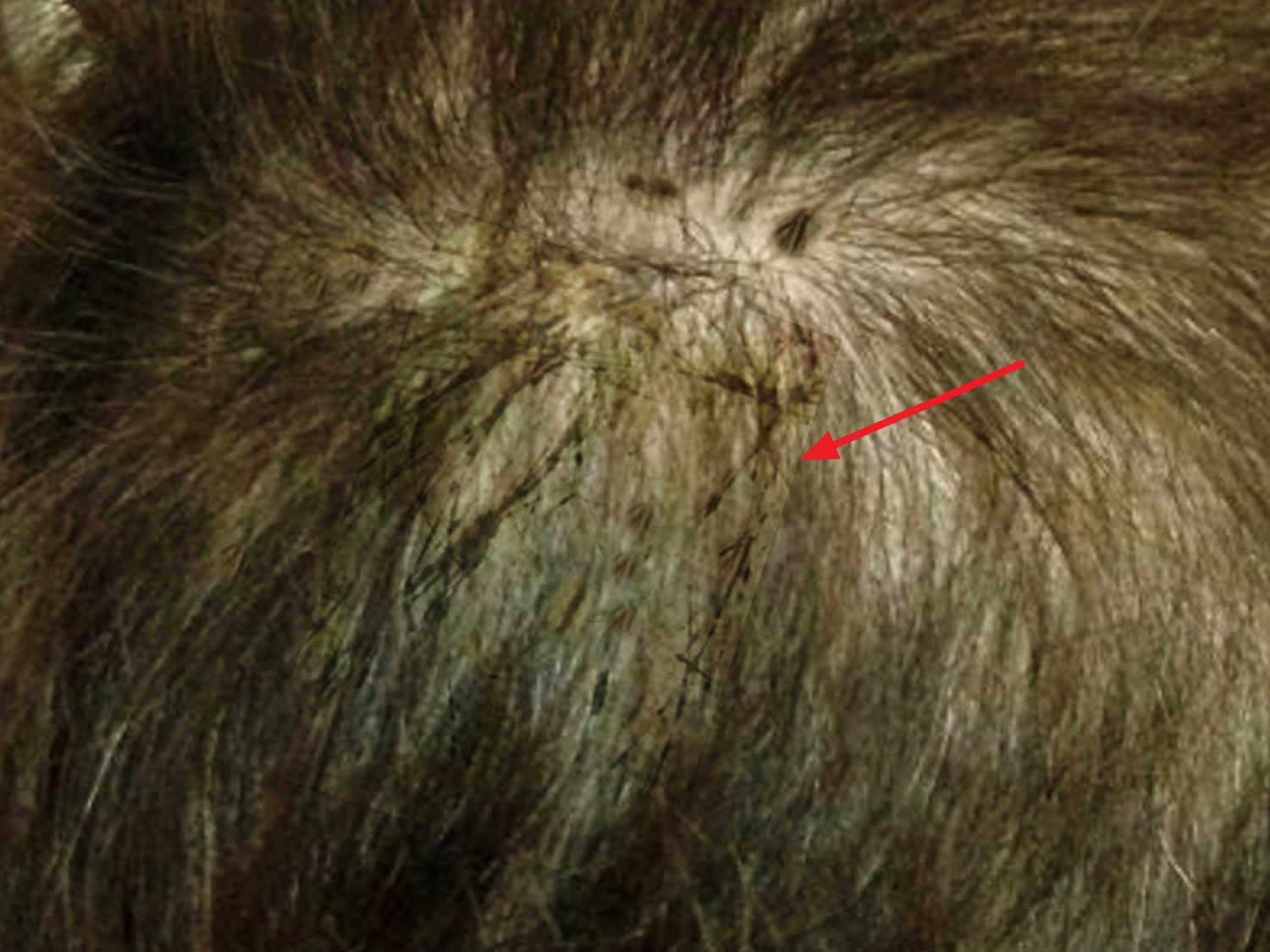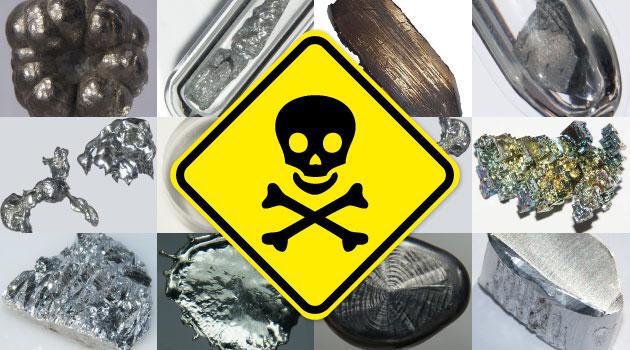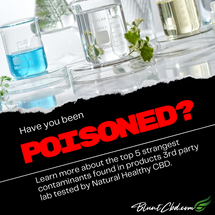Posted by Natural Healthy CBD and Blunt Media on Aug 3rd 2021
Top 10 Contaminants Found in your CBD Products
- Dermatophytes
- Moldy Weed aka Bud Rot
- Aspergillus
- Botrytis
- Cladosporium
- Piedra
- Microbials
- Listeria
- Residuial Solvents / Polycyclic Aromatic Hydrocarbons (PAHs)
- Plant Growth Regulators
- Heavy metals
- Pesticides, Insecticides and Fungicides
- Thallium
We at Natural Healthy CBD connect to a lot of people throughout the industry to ensure the right information and safest products get to the public. Oftentimes we are asked what we’re looking for in our third party labs that others don’t find? What have we found that makes a product inadmissible to our approved catalog? Have we discovered anything deadly?
Due to legalities and to remain a neutral party, we can’t release any names of the brands involved. However, we can assure that all tainted samples have been safely destroyed at the labs once they are tested positive.
Whether by accident or maliciously, without testing an industry as oddly regulated and often changing such as the cannabis industry leaves tons of loopholes and blindspots that even teams like ours can’t always catch.
In no particular order, here’s Natural Healthy's ten of the top most dangerous contaminants we’ve prevented being released to the public.
1. Dermatophytes
Dermatophytes are fungi that require keratin for growth. These fungi can cause superficial infections of the skin, hair, and nails. Dermatophytes are spread by direct contact from other people (anthropophilic organisms), animals (zoophilic organisms), and soil (geophilic organisms), as well as indirectly from fomites.
Dermatophytes are a common label for a group of fungus of Arthrodermataceae that commonly causes skin disease in animals and humans. Traditionally, these anamorphic (asexual or imperfect fungi) mold genera are: Microsporum, Epidermophyton and Trichophyton. There are about 40 species in these three genera. Species capable of reproducing sexually belong in the teleomorphic genus Arthroderma, of the Ascomycota (see Teleomorph, anamorph and holomorph for more information on this type of fungal life cycle). As of 2019 a total of nine genera are identified and new phylogenetic taxonomy has been proposed.
Some of these skin infections are known as ringworm or tinea (which is the Latin word for "worm"), though infections are not caused by worms. It is thought that the word tinea (worm) is used to describe the snake-like appearance of the dermatophyte on skin.. Toenail and fingernail infections are referred to as onychomycosis. Dermatophytes usually do not invade living tissues, but colonize the outer layer of the skin. Occasionally the organisms do invade subcutaneous tissues, resulting in kerion development.
Treatment of tinea capitis requires an oral antifungal agent; griseofulvin is the most commonly used drug, but other newer antimycotic drugs, such as terbinafine, itraconazole, and fluconazole have started to gain acceptance.
2. Fungi, Bud Rot & Moldy Weed

There are a few reasons why smoking moldy weed can cause negative health effects for just about anyone. Mold spores can survive in surprisingly harsh environmental conditions, including being burned, only to take up residence inside the warm and damp environment inside the human body. If your immune system isn’t up for the match, this can cause lung infections.
- Headache
- Fatigue
- Weakness
- Light sensitivity
- Brain fog/memory difficulties
- Cough
- Asthma or allergy attack
- Chest pain
- Dizziness
- Changes in mood
Moldy weed or hemp products can also make you sick thanks to compounds called mycotoxins and endotoxins. Mycotoxins are compounds that sit on the outside of mold spores and in small fragments of mold. They’re referred to as toxins because they are harmful to the human body, and can trigger irritation and illness. Endotoxins are molecules released by bacteria as they die. Typically, molds and endotoxins go hand-in-hand, making exposure especially agitating. Endotoxins by themselves are known to worsen symptoms of asthma and contribute to lung irritation.
Inhaling a batch of mycotoxins and endotoxins together can cause inflammation. Chronic exposure to pro-inflammatory molds and mildews can aggravate autoimmune conditions and increase your chances of developing an infection.
There are three main types of fungi often found in our sample testing.
Aspergillus
Aspergillus is a fungus that produces mycotoxins, including some that are thought to becarcinogenic. This mold can cause lung infections, which can be quite serious for those with compromised immune systems.
Back in 2011, there weretwo case studies of medical cannabis consumers who developed a condition called chronic pulmonary aspergillosis (CPA) after suspected exposure to cannabis that was infected with Aspergillus.
The condition caused symptoms of emphysema and improved after patients were treated for Aspergillus infection and refrained from cannabis consumption.
Aspergillus infections often mirror piedra infections (see #3.)
Botrytis
Botrytis is the fancy name for gray mold, and it’s one of the most common cannabis pathogens. When inhaled, this fungus can cause an allergic reaction and acute respiratory problems.
Botrytis is a genus of anamorphic fungi belonging to the Sclerotiniaceae family. Considered by many to be archetypical examples of necrotrophic fungi, they are primarily known for the damage they cause to hundreds of plant species, notably grapes, raspberries and strawberries.
The most common species of Botrytis, B.cinerea, is commonly referred to as gray mold. It first attacks a plant in the form of a white growth which over time develops into a gray mass with a velvety appearance. The gray colour originates from asexual spores (conidiospores) which can be spread by water or wind.
Cladosporium
Cladosporium is a common plant fungus that often grows on porous materials like wood and paper. It causes symptoms of hay fever and can trigger asthma attacks, though this type of mold does not produce mycotoxins. With chronic exposure, inhaling Cladosporium increases your chances of developing pneumonia.
In the worst case scenario, any mold infection can contribute to pneumonia and possibly spread to other parts of the body. Signs of acute fungal, mold and mildew exposure include:
Contact your doctor for more information if you feel you’ve been in contact with any fungi and are experiencing the above symptoms.Throw all molded products away immediately.
3. Piedra
Piedraia hortae is a superficial fungus that exists in the soils of tropical and subtropical

environments and affects both sexes of all ages. The fungus grows very slowly, forming dark hyphae, which contain chlamydoconidia cells and black colonies when grown on agar.
Piedra, which means "stone" in Spanish, is an asymptomatic superficial fungal infection of the hair shaft. In 1865, Beigel first described piedra in The Human Hair: Its Structure, Growth, Diseases, and Their Treatment; although, he may have been describing Aspergillus infection.
Black piedra is sometimes cultivated for cosmetic purposes due to social factors that favour a specific hair colour, which makes them more attractive in their society. Several Indian tribes located from Panama have been known to use several methods in order to darken the hair of albino individuals within their community. One of these methods is the cultivation of black piedra for an extensive period of time in the individual's hair.In Malaysia the nodules of black piedra are very attractive and women are encouraged to sleep with their hair buried in the soil to encourage growth of the black nodules.
In fairer skinned individuals this can cause inflammation, pain, and hair loss.
4. Microbials
“All these microorganisms can be dangerous to people, especially children, the elderly, and immunocompromised individuals,” says Conor Jenkins, lab manager at California- and Maryland-based Think20 Labs.
To make matters worse, they have no shortage of opportunities to get into your CBD product. “Contamination,” says Jenkins, “can come from the farms themselves, the processing plants, the raw materials, the packaging process, and several other places.” Many people have joked about the incongruence of selling health-boosting CBD at dingy gas stations and bodegas, but in reality contaminants are more likely to get into your product several steps earlier in the supply chain.
As Jenkins explains, “E. coli and salmonella are typically results of unclean growing/processing practices,” while “mold and yeast can come from moist [or] damp environments wherever the plant [or] other raw materials are stored.”
Microbials are Single-cell microorganisms, or microbes, found in plants that can cause intestinal distress and damage to the immune system if not kept under control. Most cannabis regulations require producers to test for total microbials and severely limit the amount available in the final form. The most commonly tested microorganisms include, but are not limited to, Escherichia coli (E. coli), salmonella, aspergillus, and any fungus.
Cannabis that has been contaminated with microbials are potentially harmful.
E. Coli and salmonella are microbials.

E. coli and salmonella are both bacteria that can cause food poisoning. You can potentially catch pathogenic E. coli from infected animals or people whereas salmonella occurs in raw poultry, eggs, beef, and occasionally unwashed fruits and vegetables.
5. Listeria
Listeria is a genus of bacteria that acts as an intracellular parasite in mammals. It is a facultative anaerobic bacterium, capable of surviving in the presence or absence of oxygen.
Symptoms may appear as late as 2 months after you have eaten something with Listeria. Listeriosis is a rare type of food poisoning caused by the bacteria Listeria monocytogenes. It is almost never found in healthy children and adults, but can affect newborns, the elderly, those who are immunocompromised and pregnant women. In some cases, it can result in meningitis.
Listeriosis can cause mild, flu-like symptoms such as fever, chills, muscle aches, and diarrhea or upset stomach. You also may have a stiff neck, headache, confusion, or loss of balance.
6. Residuial Solvents / Polycyclic Aromatic Hydrocarbons (PAHs)
To extract and process CBD from hemp or marijuana plants, many companies use industrial chemicals to help separate the cannabinoid from the plant material. Some of the most common ones include butane, propane, and ethanol — which all sound like things that belong in your grill or gas tank, not your CBD oil.
However, Jenkins believes that the fears over these particular solvents may be somewhat overblown. In the case of butane or propane, the solvent evaporates so rapidly that it tends to have disappeared by the time a product reaches its user. And while neither Jenkins — nor any medical expert — would recommend guzzling a gallon of ethanol, at the end of the day it’s still just alcohol, and a tiny amount of it is unlikely to cause serious problems.
That’s not the case for another solvent, though: Benzene. According to Jenkins, this is the most dangerous solvent found in CBD oil, because it can cause rapid cellular death. The Environmental Protection Agency (EPA) has found significant levels of the substance at 1,000 of the nation’s 1,684 most contaminated hazardous waste sites, and the World Health Organization (WHO) states that, “Human exposure to benzene has been associated with a range of acute and long-term adverse health effects and diseases, including cancer and aplastic anaemia.” (Source: Cannabismd.com)
Polycyclic aromatic hydrocarbons (PAHs) are a class of chemicals that occur naturally in coal, crude oil, and gasoline. They also are produced when coal, oil, gas, wood, garbage, and tobacco are burned. PAHs generated from these sources can bind to or form small particles in the air.
7. Plant Growth Regulators
Regulators and pesticides often aren’t thought of when considering the whole process. Plant growth regulators such as Daminozide and Paclobutraxol considered human carcinogens and are often times disrupt neurotransmitter levels in mammals are applied during plant growth and due to the terpine process are not washed off.
Washing plants is a big problem in the industry for new cultivators. Washing your plants prior to cultivation and manufacturing, you’re washing off the terpenes that are produced by the buds to give it effect. We often try to get cultivators to stay away from using them.
8. Heavy Metals

“Everyone’s heard of lead poisoning, right?,” says Jenkins — but many states have taken a curiously hands-off approach to regulating them. According to Jenkins, “There are states like Oregon that do not even require [heavy] metal testing of cannabis.” Since many labs rely on these same standards for testing CBD, this is a worrisome state of affairs — especially considering the health risks that heavy metals can pose.
Lead poisoning has become a national issue due to the ongoing tragedy in Flint, Michigan, where 100,000 people were exposed to elevated levels of lead after the city switched its water supply. Researchers found that “[fertility] rates dropped by 12 percent while fetal deaths rose by 58 percent,” as reported by PBS.
Other heavy metals can be equally harmful —as Jenkins explains, arsenic is a common ingredient in rat poison, while mercury is rapidly absorbed into the skin and lungs, where it wreaks havoc on the bloodstream.
Arsenic can be found in apples if concentrated in mass and is used in rat poisons to this day in the US. Even metals such as gold and silver can cause a shock to your system, two metals we’ve found in two separate brands this year!
Certain other metals found this year are Cadmium which causes Periodontal Disease, Pancreatic Cancer, Diabetes, Itai-Itai Disease, Lead which leads to Neurotoxic, Peripheral Neuropathy, Loss of Appetite and Weight, Chronic Fatigue and Mercury which leads to Forgetfulness, Irritability, Restricted Visual Fields, Tremors, Paranoia.
Metal poisoning can cause breathing problems and hair loss as well as neurological and mood changes. If you feel you’ve been exposed to heavy metals please contact your local center for disease control immediately.
If you have been exposed to metal or factory settings and have symptoms you can’t explain visit:https://rarediseases.org/rare-diseases/heavy-metal-poisoning/for more information on heavy metal toxicity.
9. Pesticides, Insecticides and Fungicides
Currently I am concerned about the use of glyphosates in products, especially with all of the press that is revolving around the Roundup issue. If the impact is as large as it is being reported, much more scientific testing should begin on the negative impacts on human health and regulations should change accordingly.
Glyphosate is widely regarded as a dangerous carcinogen. Bayer AG, the maker of Roundup, has been the subject of a flurry of lawsuits in recent years, with many users alleging that using the popular pesticide caused them to develop non-Hodgkin lymphoma. Recently, a California couple was awarded $2 billion in damages after a judge ruled that the pesticide was responsible for giving them bone and brain cancer.
The use of pesticides like glyphosate on hemp crops, from which most CBD is derived, is troubling because the plant is a bioaccumulator — meaning that it absorbs whatever materials are present in the soil in which it’s grown.
Abamectin, a pesticide, causes Disruption of Synaptic Processes where as fungicides like Imazalil or Myclobutanil can cause Abnormal Hormone Production.
10. Thallium
This gets interesting.
The colorless, odorless, and tasteless thallium is often reported to be used nefariously and illegally, because of its slow-acting presence and its ability to induce a wide range of symptoms. Early signs of poisoning usually begin with pain without any obvious causes, which can be easily misleading to other illnesses and conditions. Thallium poisoning is rarely encountered in emergency departments. Excessive exposure to thallium may occur in many ways, such as the maintenance and cleaning of the ducts and flues by smelters and overdosing on drugs such as cocaine and heroin. Criminal and unintentional thallium poisoning cases have also been reported, some of which have led to death. From 1995 to 2005, the American Association of Poison Control Centers reported 830 cases of human exposures to thallium, and one death from 1995 to 2009 was included. Because of the low incidence rate and nonspecific clinical manifestation of thallium poisoning, in diagnosing practice, the disease was hardly considered by physicians. In this study, a 53-year-old man with thallium poisoning was misdiagnosed on several occasions before being successfully treated. In the following 6 months of follow-up, there was no repetitive poisoning present or sequela. Finally, this case demonstrates the entire process of hair loss following thallium poisoning.
In clinical practice, thallium poisoning is very hard to diagnose, because it is a very uncommon disease and its clinical manifestations are extremely complicated. In the present study, we investigated a case of a 53-year-old man who was hospitalized for persistent stabbing pain in the abdomen and lower extremities for 20 days. Physical examination revealed diffuse alopecia of the scalp. The final diagnosis of thallium poisoning was confirmed based on high blood and urine thallium levels. The patient was cured by an oral administration of Prussian blue combined with hemoperfusion and continuous veno-venous hemofiltration or cleaning of his blood similar to dialysis. For more on this story visit: https://www.hindawi.com/journals/criem/2018/13130...
And yes… people have tried to poison us on multiple occasions. We’ve come across thallium contaminants at least 3 times this year. Odds are if thallium is involved, it was put there maliciously as it's not readily available in the states.
Zhu Ling was a sophomore majoring in physical chemistry at Tsinghua University in Beijing, China, when she mysteriously began losing hair, with accompanying stomach pain and muscle paralysis, sinking into a coma four months later. Doctors were initially baffled, but friends posted her symptoms to a Usenet group, drawing attention to Zhu Ling's plight—likely the first telemedicine trial. Physicians around the world agreed the likely cause was thallium poisoning (a toxic heavy metal sometimes used in rat poison), and her doctors treated her with the commercial dye Prussian blue, the most common antidote. (Source: https://arstechnica.com/science/2018/12/new-study...
In the past, thallium was used as a therapeutic agent to treat syphilis, gonorrhea, tuberculosis, and ringworm, and it was also used as a depilatory for excess hair. The mortality of the acute thallium poisoning is about 6% to 15%. The main cause of death is respiratory failure. Meanwhile, about 33% to 50% patients of survivors have sequelae such as nervous system diseases and visual impairment. You’ll be happy to know, your hair will grow back.
For more on this story visit: https://www.hindawi.com/journals/criem/2018/1313096/
https://arstechnica.com/science/2018/12/new-study-...
For more on cannabis contaminants visit limiting cannabis from becoming a pharmaceutical commodity: https://www.ncbi.nlm.nih.gov/pmc/articles/PMC7516211/

